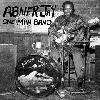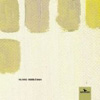 Somewhat discontinuous with Quecksilber's output thus far, which hastended to focus on works either more singular in process (ScottHorscroft's 8 Guitars) or more challenging in construction (Ambarchi & Ng's Vigil), Wirkus' third release is, nonetheless, a lovely and substantial slice of autumnal electronica. The one real surprise of Inteletto d'Amoreis that the music was created live without computer, via only threemini disc recorders, run through tremolo effects and mixed down. Ratherthan producing the kind of rough-hewn, shifting sound field that fellowlive-from-disc operator Philip Jeck diligently occupies, Wirkus'approach is much more minimal, a largely additive process where warm,melodic fragments pile up with lace-like delicacy, tracing comfortablewall-patterns. The artist's mini discs sample string quartets, pianopieces, and droning amplifier hiss, all extremely welcoming sounds,placed with enough economy and tasteful repetition to create stablepieces, thick with the hazy lull that people like Jeck and Fenneszconcoct regularly. What they lack in uniqueness, Wirkus' songs make upwith a quality of intimacy that often feels lacking in similarproductions, where the music's melancholic or nostalgic focus threatensto push it towards a remote, bookish level of engagement. Each trackseems cut from the same slow, thoughtful mold, an easy incline into atender plateau where melodious fragments graze the inside of grainystring loops or gentle static envelopes. Wirkus' pacing is entirelyappropriate given the warmth and level luster of the sounds used, andnothing here suffers from thinning structure or a lukewarm melodicsensibility. Inteletto d'Amore's only odd moment comes in thesecond track, "Blask," where the artist adds a vocal over the disc'sonly overtly rhythmic loop (of common amp hum and golden feedback).Sounding eerily like Alan Vega, Wirkus utters a breathy chant thatdoesn't really connect with the comforts of the record overall, and heseems to know this, calling up a hesitant, last-minute delivery withthe same minimal variation as his hypnotic backgrounds. One misstepaside, the disc, while unremarkable, will still demand return listensfrom most fans of experimental electronica or anyone looking for someabsorbing sonic wallpaper.
Somewhat discontinuous with Quecksilber's output thus far, which hastended to focus on works either more singular in process (ScottHorscroft's 8 Guitars) or more challenging in construction (Ambarchi & Ng's Vigil), Wirkus' third release is, nonetheless, a lovely and substantial slice of autumnal electronica. The one real surprise of Inteletto d'Amoreis that the music was created live without computer, via only threemini disc recorders, run through tremolo effects and mixed down. Ratherthan producing the kind of rough-hewn, shifting sound field that fellowlive-from-disc operator Philip Jeck diligently occupies, Wirkus'approach is much more minimal, a largely additive process where warm,melodic fragments pile up with lace-like delicacy, tracing comfortablewall-patterns. The artist's mini discs sample string quartets, pianopieces, and droning amplifier hiss, all extremely welcoming sounds,placed with enough economy and tasteful repetition to create stablepieces, thick with the hazy lull that people like Jeck and Fenneszconcoct regularly. What they lack in uniqueness, Wirkus' songs make upwith a quality of intimacy that often feels lacking in similarproductions, where the music's melancholic or nostalgic focus threatensto push it towards a remote, bookish level of engagement. Each trackseems cut from the same slow, thoughtful mold, an easy incline into atender plateau where melodious fragments graze the inside of grainystring loops or gentle static envelopes. Wirkus' pacing is entirelyappropriate given the warmth and level luster of the sounds used, andnothing here suffers from thinning structure or a lukewarm melodicsensibility. Inteletto d'Amore's only odd moment comes in thesecond track, "Blask," where the artist adds a vocal over the disc'sonly overtly rhythmic loop (of common amp hum and golden feedback).Sounding eerily like Alan Vega, Wirkus utters a breathy chant thatdoesn't really connect with the comforts of the record overall, and heseems to know this, calling up a hesitant, last-minute delivery withthe same minimal variation as his hypnotic backgrounds. One misstepaside, the disc, while unremarkable, will still demand return listensfrom most fans of experimental electronica or anyone looking for someabsorbing sonic wallpaper.Abner Jay was a classic ragtime song-and-dance man, learning his trade with Silas Green's Minstrels in the 1930's and WMAZ Minstrels in Macon during the 40's and 18's. Lap dissolve to the late 60's, and Abner Jay had transformed himself into a one-man-band and traveling nostalgia revue, issuing a series of private press LPs that now trade hands for ridiculously high prices. Sweden's Subliminal Sounds recently released this compilation, collecting material from three of Jay's best albums.
Jay billed himself as America's Last Minstrel Show, and he played an energetic combo of finger-picked banjo and harmonica, working the bass drum with a foot pedal. He introduced each song with bad puns and raunchy jokes, his deep Southern drawl a deliberate caricature of old-time Uncle Tom minstrelsy. It would be tempting to dismiss Abner Jay as a politically-incorrect anachronism, were it not for the obvious talent and intelligence with which he approaches his racially-charged material. By fearlessly accentuating the house Negro stereotypes that defined and imprisoned black performers in the post-Civil War South, Abner Jay is able to transcend them, exorcising the pain of his ancestry.
Nowhere is this more clear than in the heart-breaking song "I'm So Depressed," a track so beautiful and haunting that it floored me upon first listen. Beginning as a traditional-sounding blues lament, Jay's voice suddenly shifts into a high lonesome wail, choking back tears and belting out a series of deeply felt emotional cries that express an ancient sadness. "I was born during the hard depression days...My folks were sharecroppers/We had nothing, we had nothing, we had nothing/But grasshoppers/Looking back over my life/O lord, I'm so depressed."
On "Swaunee," Jay talks at length about his beloved Southern river, it's legacy and importance. Jay's narration is layered over an atmospheric instrumental track punctuated by the chorus of the traditional song, treated to sound like an old 78. Because of my penchant for outsider music, I have heard hundreds of hyped reissues of vanity pressings and much-vaunted musical oddities. Rarely have I heard anything as impressive as Abner Jay's evocative, recollective race-folk. One Man Band is currently the only widely available edition of his music, making it absolutely essential.
 The glam rock era was the first time that popular music openly acknowledged its own superficial tendencies. The first time that the extravagance, glitter and condescension attendant to the rock n' roll lifestyle became an aesthetic badge of honor. Glam, through its emphasis on the primacy of make-up, wardrobe and snarling supercilious attitude, was pop music's first postmodern movement, containing both the substance of rock n' roll, and the commentary on the same. As such, it created a fleeting moment in history where anyone with the right combination of style, poise and bearing could become an overnight sensation, and often just as quickly fade into obsolescence.
The glam rock era was the first time that popular music openly acknowledged its own superficial tendencies. The first time that the extravagance, glitter and condescension attendant to the rock n' roll lifestyle became an aesthetic badge of honor. Glam, through its emphasis on the primacy of make-up, wardrobe and snarling supercilious attitude, was pop music's first postmodern movement, containing both the substance of rock n' roll, and the commentary on the same. As such, it created a fleeting moment in history where anyone with the right combination of style, poise and bearing could become an overnight sensation, and often just as quickly fade into obsolescence.
 Stern and Northam are far from an incompatible pair. Both artists havebeen actively confusing environmental (or "natural") sound andelectronic composition for many years, becoming prominent practitionersof an incredibly tactile, dimension-bending style of electroacousticmusic. The success of their output is as much a product of newtechnology as it is the result of the artists' willingness to plumb thedepths of the world's rubbish bins, forest floors, and highwayshoulders in search of "new" sound devices. Northam, in particular, hasassembled a dense body of work based largely on the rejection ofinstruments with any kind of outside referent, including keen effortsto avoid sound which gives evidence of even the most primitive forms ofmusicianship (i.e. strumming, beating). The artist gathers sound from atable of indiscriminant objects, where man-made refuse, natural forms,and all combinations in between enter the microphone field and feed thegloss of cracks, scrapes, and sandy shivers that become the basis forhis alienating contributions. Northam's music reveals itself as organicbut untraceable; by simulating and warping "natural" sounds, hedemonstrates an interest in examining the process by whichenvironmental sound is internalized, filed away for easy, oftenunreliable reference. Northam's sophisticated process of manipulationallows for something like a "telescoping" of sound events to occur, inwhich certain details are blown up within the already intricateassemblage. Microscopic wrinkles and chirps turn, with surprisingfluidity, to craggy landscapes and squealing waveforms, creating subtledislocations of distance that compound the initial disorientationbrought on by traceless noises. The effect is like passing a magnifyingglass over a mossy creekbed and watching as small green worlds leapinto unexpected life. Wormwood'ssituation is made more complex by the chorus of high-pitched drones andgentle, processed feedback that rise from each piece, giving the disc'ssharper points a soothing undertone and, at times, lifting the surfacenoise toward snarling crescendos. Based on my knowledge of the artists'previous work, I'm guessing these extended tones are Stern's, thoughit's possible that he's equally responsible for the disc's grittiertextures. Whatever the case, the synthetic quality of the backing soundprovides a nice contrast to the mad scramble that remains the music'sprimary focus, working to create many fine moments of expertlyexploited detail and interesting contrast. And while Wormwood hardly rivals some of Northam's grandiose solo works like :coyot:and From Within the Solar Cave, the disc also feels unique and is no easier to pin down.
Stern and Northam are far from an incompatible pair. Both artists havebeen actively confusing environmental (or "natural") sound andelectronic composition for many years, becoming prominent practitionersof an incredibly tactile, dimension-bending style of electroacousticmusic. The success of their output is as much a product of newtechnology as it is the result of the artists' willingness to plumb thedepths of the world's rubbish bins, forest floors, and highwayshoulders in search of "new" sound devices. Northam, in particular, hasassembled a dense body of work based largely on the rejection ofinstruments with any kind of outside referent, including keen effortsto avoid sound which gives evidence of even the most primitive forms ofmusicianship (i.e. strumming, beating). The artist gathers sound from atable of indiscriminant objects, where man-made refuse, natural forms,and all combinations in between enter the microphone field and feed thegloss of cracks, scrapes, and sandy shivers that become the basis forhis alienating contributions. Northam's music reveals itself as organicbut untraceable; by simulating and warping "natural" sounds, hedemonstrates an interest in examining the process by whichenvironmental sound is internalized, filed away for easy, oftenunreliable reference. Northam's sophisticated process of manipulationallows for something like a "telescoping" of sound events to occur, inwhich certain details are blown up within the already intricateassemblage. Microscopic wrinkles and chirps turn, with surprisingfluidity, to craggy landscapes and squealing waveforms, creating subtledislocations of distance that compound the initial disorientationbrought on by traceless noises. The effect is like passing a magnifyingglass over a mossy creekbed and watching as small green worlds leapinto unexpected life. Wormwood'ssituation is made more complex by the chorus of high-pitched drones andgentle, processed feedback that rise from each piece, giving the disc'ssharper points a soothing undertone and, at times, lifting the surfacenoise toward snarling crescendos. Based on my knowledge of the artists'previous work, I'm guessing these extended tones are Stern's, thoughit's possible that he's equally responsible for the disc's grittiertextures. Whatever the case, the synthetic quality of the backing soundprovides a nice contrast to the mad scramble that remains the music'sprimary focus, working to create many fine moments of expertlyexploited detail and interesting contrast. And while Wormwood hardly rivals some of Northam's grandiose solo works like :coyot:and From Within the Solar Cave, the disc also feels unique and is no easier to pin down.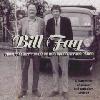 For better or worse, many artists slip through the cracks, their worktoo idiosyncratic or esoteric to ignite any interest in the public. Asunfortunate as it is when great art is ignored, it creates the perfectsituation for record collectors and rare music enthusiasts, who deriveendless pleasure from discovering innovative music that wasmarginalized in its era. Once called "Britain's pop Salinger," a namethat is accurate in more ways than one, Bill Fay's unique discographyis perfectly suited for a renaissance of interest and enthusiasm. BillFay recorded two fabulously rare LPs in the early 70's that combinedhis acerbic wit, impressionistic lyrics and apocalyptic religioussymbolism with huge, Scott Walker-style MOR string arrangements andpsychedelic guitar riffs. His songwriting talent is immense, craftingMcCartney-esque pop masterpieces that seem entirely alien to thebizarre, hallucinogenic lyrical themes. Both his debut self-titledalbum and the follow-up Time of the Last Persecutionwere issued together on CD by the now-defunct See For Miles label, andhave since gone out of print. David Tibet's Durtro Records is on theverge of issuing Fay's unreleased third album Tomorrow and Tomorrow.In the interim, British rare-psych label Tenth Planet has released thiscollection of 25 early demos and outtakes on their Wooden Hill imprint.These demos include never-before-heard songs as well as nascentversions of tracks that eventually appeared on the two LPs. This is anextremely exciting release for Bill Fay converts, but it is far fromessential for newcomers, who would be advised to seek out one of histwo original LPs. The recording quality of many of the original tapesis rather poor, and the digital conversion doesn't seem to have helpedmuch. Further, Bill Fay's artistic voice is not as strong in some ofthe earlier material, which seems at first listen a little too similarto The Beatles. Tracks like "Warwick Town" and "Maxine's Parlour" arefine examples of urbane British psych-pop, but they rarely reach thetranscendent weirdness of his later work. However, there are many gemsto be found on Grandfather Clock. The haunting early version of"Garden Song" included here is startling, highlighting Fay's beatificdelivery on spaced-out lines like: "I'm planting myself in thegarden/Between the potatoes and parsley/And I'll wait for the grain toanoint me/And the frost to awaken my soul/I'm looking for lastingrelations/With a green fly, spider or maggot." Though I have a deepaffection for the extravagant string and horn arrangements on thealbums, it's fascinating to hear these songs liberated from the denseproduction. This collection quietly proves that Bill Fay was much morethan an amusing footnote in the history of British psych-pop; he was aliterate and emotive songwriter of the highest order.
For better or worse, many artists slip through the cracks, their worktoo idiosyncratic or esoteric to ignite any interest in the public. Asunfortunate as it is when great art is ignored, it creates the perfectsituation for record collectors and rare music enthusiasts, who deriveendless pleasure from discovering innovative music that wasmarginalized in its era. Once called "Britain's pop Salinger," a namethat is accurate in more ways than one, Bill Fay's unique discographyis perfectly suited for a renaissance of interest and enthusiasm. BillFay recorded two fabulously rare LPs in the early 70's that combinedhis acerbic wit, impressionistic lyrics and apocalyptic religioussymbolism with huge, Scott Walker-style MOR string arrangements andpsychedelic guitar riffs. His songwriting talent is immense, craftingMcCartney-esque pop masterpieces that seem entirely alien to thebizarre, hallucinogenic lyrical themes. Both his debut self-titledalbum and the follow-up Time of the Last Persecutionwere issued together on CD by the now-defunct See For Miles label, andhave since gone out of print. David Tibet's Durtro Records is on theverge of issuing Fay's unreleased third album Tomorrow and Tomorrow.In the interim, British rare-psych label Tenth Planet has released thiscollection of 25 early demos and outtakes on their Wooden Hill imprint.These demos include never-before-heard songs as well as nascentversions of tracks that eventually appeared on the two LPs. This is anextremely exciting release for Bill Fay converts, but it is far fromessential for newcomers, who would be advised to seek out one of histwo original LPs. The recording quality of many of the original tapesis rather poor, and the digital conversion doesn't seem to have helpedmuch. Further, Bill Fay's artistic voice is not as strong in some ofthe earlier material, which seems at first listen a little too similarto The Beatles. Tracks like "Warwick Town" and "Maxine's Parlour" arefine examples of urbane British psych-pop, but they rarely reach thetranscendent weirdness of his later work. However, there are many gemsto be found on Grandfather Clock. The haunting early version of"Garden Song" included here is startling, highlighting Fay's beatificdelivery on spaced-out lines like: "I'm planting myself in thegarden/Between the potatoes and parsley/And I'll wait for the grain toanoint me/And the frost to awaken my soul/I'm looking for lastingrelations/With a green fly, spider or maggot." Though I have a deepaffection for the extravagant string and horn arrangements on thealbums, it's fascinating to hear these songs liberated from the denseproduction. This collection quietly proves that Bill Fay was much morethan an amusing footnote in the history of British psych-pop; he was aliterate and emotive songwriter of the highest order.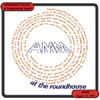 This 1972 recording catches the iconoclastic British improv ensemble around the time of To Hear and Back Again,where the group was temporarily reduced to the duo of saxophonist LouGare and drummer Eddie Prévost. This is the interim period coming afterAMM's first recordings, those groundbreaking mini-epics of sax andstring-strewn factory ambience, and before the group's later, arguablymore "mature" phase, marked by the introduction of John Tilbury's pianoand a calmer, more subtle playing style. In '72, the temporary absenceof Keith Rowe's tabletop guitar and electronics meant the disappearanceof nearly all of the colorful industrial abstractions that made thegroup's early work such an unclassifiable joy, and in response, the duoof Gare and Prévost dips heavily into free jazz for this performance atLondon's Roundhouse, anticipating their work on Hear and Backtwo years later. The players are clearly competent and practicedcommunicators, making the disc's 47 minutes ample time for a few dozenbeautiful moments to emerge, but it's easy to feel disappointed with Roundhouseas it's really only a sidestep in the path of a group whose best worklies both ahead and behind. Gare demonstrates a keen appreciation forthe free-fractured melodic style of late-period Coltrane, merging withthe wayward stabs of Arkestran contemporary John Gilmore; however theseabilities had been previously established on the first two AMM recordswhere they found brighter placement within the rich textures of theexpanded ensemble, alongside Cornelius Cardew's disembodied cello. Thesaxophonist is more impressive during Roundhouse's quieterpassages where, removed from distraction or compliment, the soft arcs,low warbles, and the other more textural elements of his playing can befully appreciated (and picked out of other recordings). Prévost'splaying is, for the most part, a disappointment. Given the completelyalien repertoire of sound I know the drummer to be capable of, hisrelatively straight-laced performance here becomes my biggest criticismof the disc. Prévost might have been forgiven had he hung back to allowfor more subdued interaction with Gare's tenor, but instead he insistson punctuating most everything with tight, exhaustive snare rolls thatprove tedious before the halfway point. In contrast to other AMM discswhere one unbroken piece receives (seemingly) arbitrary trackdivisions, Roundhouse's single track includes numerous pauses,which, oddly enough, become the music's biggest asset. Continuallyeasing their instruments into and out of silence, Gare and Prévost areforced to repeatedly regenerate the piece from scratch, moldinglistener anticipation and crafting an increasingly complex work. Also,the recording leaves a considerable amount of audience noise and roomambience audible, allowing these sounds to blend with those from thetwo musicians and recalling the famous AMM credo: "Every noise has anote." During particular lulls in the playing, as distant coughs andshuffles enter the mix, I can almost hear the static edge of the absentRowe's shortwave radio, as if this room and these people were justsomething he was lucky enough to find on the dial as the sax and drumsstarted to die down. Moments like these are enough to make Roundhouse worthwhile and to remind me that even mediocre AMM discs make for irresistible listening.
This 1972 recording catches the iconoclastic British improv ensemble around the time of To Hear and Back Again,where the group was temporarily reduced to the duo of saxophonist LouGare and drummer Eddie Prévost. This is the interim period coming afterAMM's first recordings, those groundbreaking mini-epics of sax andstring-strewn factory ambience, and before the group's later, arguablymore "mature" phase, marked by the introduction of John Tilbury's pianoand a calmer, more subtle playing style. In '72, the temporary absenceof Keith Rowe's tabletop guitar and electronics meant the disappearanceof nearly all of the colorful industrial abstractions that made thegroup's early work such an unclassifiable joy, and in response, the duoof Gare and Prévost dips heavily into free jazz for this performance atLondon's Roundhouse, anticipating their work on Hear and Backtwo years later. The players are clearly competent and practicedcommunicators, making the disc's 47 minutes ample time for a few dozenbeautiful moments to emerge, but it's easy to feel disappointed with Roundhouseas it's really only a sidestep in the path of a group whose best worklies both ahead and behind. Gare demonstrates a keen appreciation forthe free-fractured melodic style of late-period Coltrane, merging withthe wayward stabs of Arkestran contemporary John Gilmore; however theseabilities had been previously established on the first two AMM recordswhere they found brighter placement within the rich textures of theexpanded ensemble, alongside Cornelius Cardew's disembodied cello. Thesaxophonist is more impressive during Roundhouse's quieterpassages where, removed from distraction or compliment, the soft arcs,low warbles, and the other more textural elements of his playing can befully appreciated (and picked out of other recordings). Prévost'splaying is, for the most part, a disappointment. Given the completelyalien repertoire of sound I know the drummer to be capable of, hisrelatively straight-laced performance here becomes my biggest criticismof the disc. Prévost might have been forgiven had he hung back to allowfor more subdued interaction with Gare's tenor, but instead he insistson punctuating most everything with tight, exhaustive snare rolls thatprove tedious before the halfway point. In contrast to other AMM discswhere one unbroken piece receives (seemingly) arbitrary trackdivisions, Roundhouse's single track includes numerous pauses,which, oddly enough, become the music's biggest asset. Continuallyeasing their instruments into and out of silence, Gare and Prévost areforced to repeatedly regenerate the piece from scratch, moldinglistener anticipation and crafting an increasingly complex work. Also,the recording leaves a considerable amount of audience noise and roomambience audible, allowing these sounds to blend with those from thetwo musicians and recalling the famous AMM credo: "Every noise has anote." During particular lulls in the playing, as distant coughs andshuffles enter the mix, I can almost hear the static edge of the absentRowe's shortwave radio, as if this room and these people were justsomething he was lucky enough to find on the dial as the sax and drumsstarted to die down. Moments like these are enough to make Roundhouse worthwhile and to remind me that even mediocre AMM discs make for irresistible listening.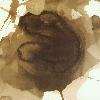 Little Annie and the Legally Jammin' finds the veteran artist ata crossroads between the past and the present; between the abrasive dubexperimentalism of her early work and the slick sex appeal of moderntechno; between brutal, incendiary poetry and lyrical high camp;between the personal and the superficial; between grim reality andairbrushed artifice. That Little Annie "Anxiety" Bandez is so adept attowing this precarious gap while maintaining an unshakable poise is atestament to her singular skills as a vocalist, lyricist, poet,provocateur and chanteuse. Annie's delivery hasn't missed a beat inmore than 20 years, riding a similar wavelength as Marianne Faithful,Lydia Lunch and Diamanda Galas, but carving out her own uniquelyblaise, street-savvy growl. For The Legally Jammin', Anniebrings together a posse of talented collaborators including Can "Khan"Oral, taking a break from the homoerotic electro of Captain Comatose tocontribute a series of languid, bass-heavy beats to the album. Alsonotable are the contributions of Kid Congo Powers, a former member ofThe Bad Seeds, The Cramps, and the terrific, all-but-forgotten 80'scult band Gun Club. On past collaborations between Khan and Kid CongoPowers, their diverse musical influences resulted in a bluesyelectro-punk hybrid uniquely their own, and it's very much on displayin the settings they create for Little Annie's satiny vocals. All thesongs on the album have a tense, vaguely threatening undercurrent thatsneaks invisibly behind the eroticism of the smooth, sparse production.The resonant bass hits and percolating dub echoes are in full effect onthe album's provocative opener "Bleach." Annie tells us to "love thesinner, hate the sin/love the battle, hate the war/love the saint andlove the whore." Annie keeps a gun beside her bed, "in case successgoes to my head/or just in case it don't." She pauses mid-album for acampy, off-the-cuff monologue about a drag queen that displaysrazor-sharp wit and obscenity of a William S. Burroughs routine. Theserpentine industrial throbs of "Blacktrack Jack" supply the perfectcounterpart to Annie's laundry-list of apocalyptic imagery: "Phoneringing, kids crying, brakes screeching, heads rolling, tears flowing,pipes bursting...head pounding, pleasure mounting, dreams bursting,pockets hurting, prices rising." The album concludes with alanguorously reworked version of "Sugar Bowl," a song from Annie'searly-90's collaborations with On U-Sound superstars. The Legally Jammin' is an alluringly sweet confectionary treat from a talented artist.
Little Annie and the Legally Jammin' finds the veteran artist ata crossroads between the past and the present; between the abrasive dubexperimentalism of her early work and the slick sex appeal of moderntechno; between brutal, incendiary poetry and lyrical high camp;between the personal and the superficial; between grim reality andairbrushed artifice. That Little Annie "Anxiety" Bandez is so adept attowing this precarious gap while maintaining an unshakable poise is atestament to her singular skills as a vocalist, lyricist, poet,provocateur and chanteuse. Annie's delivery hasn't missed a beat inmore than 20 years, riding a similar wavelength as Marianne Faithful,Lydia Lunch and Diamanda Galas, but carving out her own uniquelyblaise, street-savvy growl. For The Legally Jammin', Anniebrings together a posse of talented collaborators including Can "Khan"Oral, taking a break from the homoerotic electro of Captain Comatose tocontribute a series of languid, bass-heavy beats to the album. Alsonotable are the contributions of Kid Congo Powers, a former member ofThe Bad Seeds, The Cramps, and the terrific, all-but-forgotten 80'scult band Gun Club. On past collaborations between Khan and Kid CongoPowers, their diverse musical influences resulted in a bluesyelectro-punk hybrid uniquely their own, and it's very much on displayin the settings they create for Little Annie's satiny vocals. All thesongs on the album have a tense, vaguely threatening undercurrent thatsneaks invisibly behind the eroticism of the smooth, sparse production.The resonant bass hits and percolating dub echoes are in full effect onthe album's provocative opener "Bleach." Annie tells us to "love thesinner, hate the sin/love the battle, hate the war/love the saint andlove the whore." Annie keeps a gun beside her bed, "in case successgoes to my head/or just in case it don't." She pauses mid-album for acampy, off-the-cuff monologue about a drag queen that displaysrazor-sharp wit and obscenity of a William S. Burroughs routine. Theserpentine industrial throbs of "Blacktrack Jack" supply the perfectcounterpart to Annie's laundry-list of apocalyptic imagery: "Phoneringing, kids crying, brakes screeching, heads rolling, tears flowing,pipes bursting...head pounding, pleasure mounting, dreams bursting,pockets hurting, prices rising." The album concludes with alanguorously reworked version of "Sugar Bowl," a song from Annie'searly-90's collaborations with On U-Sound superstars. The Legally Jammin' is an alluringly sweet confectionary treat from a talented artist.  Bobby Conn was so much more charming when he was singing about akwardsexual experiences, teenage cocaine parties and giving blowjobs toadvance in the corporate world. Now that he's aimed his rapier wit atthe ridiculously easy target of the Bush administration, he misses themark almost completely. Perhaps my dislike for The Homelandstems from a fundamental belief that politics and rock n' roll areuneasy bedfellows. I've heard a precious few protest albums that didn'tseem completely dated mere weeks after their release, and they weremade by much shrewder artists that the diminutive Mr. Conn. He and hisband of Glass Gypsies wade through a turgid song cycle satirizing rabidconservatism, "homeland security" and Bush's imperialistic foreignpolicy. Maybe it's me, but don't these seem like rather obvioustargets? Does President Bush - a man so clearly idiotic, insane andwilling to distort the truth in order to further his own nefariouscauses - really need to be lampooned in a series of pastiches on 70'sglam and arena rock? I think The Homeland answers thatquestion, and the answer is a resounding "no." Save for one lonelytrack, there are no memorable tunes on the album, most of the musicstruggling to fit Mr. Conn's convoluted lyrics. Producer John McEntireattempts to compensate for the songwriting's obvious shortcomings byover-arranging every song, introducing a multitude of synthesizers,organs, percussion and strings so that every moment is overwhelmed withcomposition. On the album's opening track, "We Come in Peace," Conntries to graft idiotic lines like "We are your friends, we come inpeace/We brought our guns to set you free" onto the same Boston-styleclassic rock mold that made his last album The Golden Age sohilarious and memorable. Other tracks attempt poor imitations BobbyConn's myriad other influences. Their only entertainment value lies intrying to identify which artist Conn is badly impersonating: the titletrack is Yes' "Heart of the Sunrise," "Relax" takes its cue fromPrince, and "Home Sweet Home" is a piss-poor facsimile of Hunky Dory-eraBowie. "Bus #243" is a lone bright spot, a rollicking song thatdeserves a better place than this record in which to thrive. Then,suddenly and without warning, Conn summarily loses the plot, droppinghis theme for four full tracks before attempting to regain it with thefinal track. I really hate it when artists refuse to follow up properlyon their own stated goals.
Bobby Conn was so much more charming when he was singing about akwardsexual experiences, teenage cocaine parties and giving blowjobs toadvance in the corporate world. Now that he's aimed his rapier wit atthe ridiculously easy target of the Bush administration, he misses themark almost completely. Perhaps my dislike for The Homelandstems from a fundamental belief that politics and rock n' roll areuneasy bedfellows. I've heard a precious few protest albums that didn'tseem completely dated mere weeks after their release, and they weremade by much shrewder artists that the diminutive Mr. Conn. He and hisband of Glass Gypsies wade through a turgid song cycle satirizing rabidconservatism, "homeland security" and Bush's imperialistic foreignpolicy. Maybe it's me, but don't these seem like rather obvioustargets? Does President Bush - a man so clearly idiotic, insane andwilling to distort the truth in order to further his own nefariouscauses - really need to be lampooned in a series of pastiches on 70'sglam and arena rock? I think The Homeland answers thatquestion, and the answer is a resounding "no." Save for one lonelytrack, there are no memorable tunes on the album, most of the musicstruggling to fit Mr. Conn's convoluted lyrics. Producer John McEntireattempts to compensate for the songwriting's obvious shortcomings byover-arranging every song, introducing a multitude of synthesizers,organs, percussion and strings so that every moment is overwhelmed withcomposition. On the album's opening track, "We Come in Peace," Conntries to graft idiotic lines like "We are your friends, we come inpeace/We brought our guns to set you free" onto the same Boston-styleclassic rock mold that made his last album The Golden Age sohilarious and memorable. Other tracks attempt poor imitations BobbyConn's myriad other influences. Their only entertainment value lies intrying to identify which artist Conn is badly impersonating: the titletrack is Yes' "Heart of the Sunrise," "Relax" takes its cue fromPrince, and "Home Sweet Home" is a piss-poor facsimile of Hunky Dory-eraBowie. "Bus #243" is a lone bright spot, a rollicking song thatdeserves a better place than this record in which to thrive. Then,suddenly and without warning, Conn summarily loses the plot, droppinghis theme for four full tracks before attempting to regain it with thefinal track. I really hate it when artists refuse to follow up properlyon their own stated goals.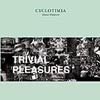 Within 25 minutes of pressing play everything in this space will bebleached, cleansed, and returned to its proper place. There is nothingout of place, no surface smudged, and no voices speaking aboveeachother; everything is closely, carefully, and painfully monitored.Cyclotimia's cold, cold presentation makes the setting of Orwell's 1984seem like a happy place filled with the vibrant activity of free andstrong people. The mechanical and soulless presentation makes sense,though: Trivial Pleasures comes with a booklet that outlinesNasdaq's personal mission statement and provides information on"Miniaturized, Implantable Identification Technology;" the implicationis clearly that of a Big Brother atmosphere. In addition, this albumwas apparently inspired by Wim Merten's For Amusement Only, acomposition written for pinball machines. The inspiration shows: manyof the sounds are repeated loops of chimey and high pitched ringsmodulating through various tones. The effect is dizzying and somewhatfrightening. The sounds of knives scratching together crash into achaos of tin and other metals crushing together while synthesizers moandeep beneath the surface of some icey landscape - this is not intendedfor pleasant afternoon listening. For all of its alien facts, Trivial Pleasuresis surprisingly fun to listen to. There's an element of cynicism thathas to be appreciated in songs like "Market Experts." Horrible machinesused to grind human bones to pulp churn underneath a repeated vocalloop... "analyzed by experts, analyzed by experts, analyzed byexperts." Everything is perfectly safe, trust me! All that happens hereis in the best interest of the people! Nothing here could be possiblybe of any harm, right? And with a laugh Cyclotimia grin and continue togrind out the choking sound of capitalist industry. Though this kind ofjumbled noise would normally turn me off, Trivial Pleasures manages to keep my interest. Granted, it's a short album, but that only works to its advantage.
Within 25 minutes of pressing play everything in this space will bebleached, cleansed, and returned to its proper place. There is nothingout of place, no surface smudged, and no voices speaking aboveeachother; everything is closely, carefully, and painfully monitored.Cyclotimia's cold, cold presentation makes the setting of Orwell's 1984seem like a happy place filled with the vibrant activity of free andstrong people. The mechanical and soulless presentation makes sense,though: Trivial Pleasures comes with a booklet that outlinesNasdaq's personal mission statement and provides information on"Miniaturized, Implantable Identification Technology;" the implicationis clearly that of a Big Brother atmosphere. In addition, this albumwas apparently inspired by Wim Merten's For Amusement Only, acomposition written for pinball machines. The inspiration shows: manyof the sounds are repeated loops of chimey and high pitched ringsmodulating through various tones. The effect is dizzying and somewhatfrightening. The sounds of knives scratching together crash into achaos of tin and other metals crushing together while synthesizers moandeep beneath the surface of some icey landscape - this is not intendedfor pleasant afternoon listening. For all of its alien facts, Trivial Pleasuresis surprisingly fun to listen to. There's an element of cynicism thathas to be appreciated in songs like "Market Experts." Horrible machinesused to grind human bones to pulp churn underneath a repeated vocalloop... "analyzed by experts, analyzed by experts, analyzed byexperts." Everything is perfectly safe, trust me! All that happens hereis in the best interest of the people! Nothing here could be possiblybe of any harm, right? And with a laugh Cyclotimia grin and continue togrind out the choking sound of capitalist industry. Though this kind ofjumbled noise would normally turn me off, Trivial Pleasures manages to keep my interest. Granted, it's a short album, but that only works to its advantage.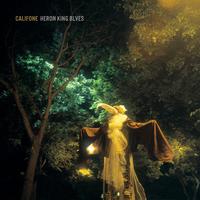 The opening notes of "Wingbone," sharp and clear as a bell are asdirect as Califone wishes to get on their new record. The trackpossesses a tightness and clarity of meaning that will slip away acrossthe rest of the record, though not in a bad way. Every strum and pluckrings out beautifully, vividly presenting itself before slowly fadingback into the darkness. Of all the tracks on Heron King Blues,this one is the most organic and most immediately satisfying, anintroduction to the extended dream about to be let loose and spill outits unconscious thoughts without elaboration. The music was crafted ina manner similar to the bands previous Declaration releases,either wholly improvised or devised in the studio. After the rawmaterials are put to tape, they are put through the process, cut,dubbed, and patched into an electro-acoustic meld. This approachdeepens to drifting, dreamlike sprawl that pervades the record. "Apple"is dominantly percussive, bubbling with a collage of sounds ofindeterminate origin, some pastiche of real drums and mechanicalapproximations that along with Tim Rutili's hushed, choppy vocalsgivethe track a compellingly breathless tempo. "2 Sisters Drunk on EachOther" is far removed from the pastoral feel of the rest of the disc,with chiming guitars and a flanged and funky bass line. Overdubbedhorns criss-cross over one another, squealing out nonsense melodies.This track seems as if it would be right at home mixed into a dance setlist. Though it does stick out on the disc, it is distinctly Califone,pitting sound against sound ever so subtly to develop tension andenergy in a subdued way. The title track, spanning almost fifteenminutes, is an elongated jam session that puts the strengths of theband's improvisation skills and the attentiveness of the listener tothe test. While there are intriguing moments in the midst, it can besomewhat taxing. By its end, Heron King Blues has escaped formand function and spun off into a nebulous place, the band finding theirvoice in that mist as strong (if not as clear) as it is on solidground.
The opening notes of "Wingbone," sharp and clear as a bell are asdirect as Califone wishes to get on their new record. The trackpossesses a tightness and clarity of meaning that will slip away acrossthe rest of the record, though not in a bad way. Every strum and pluckrings out beautifully, vividly presenting itself before slowly fadingback into the darkness. Of all the tracks on Heron King Blues,this one is the most organic and most immediately satisfying, anintroduction to the extended dream about to be let loose and spill outits unconscious thoughts without elaboration. The music was crafted ina manner similar to the bands previous Declaration releases,either wholly improvised or devised in the studio. After the rawmaterials are put to tape, they are put through the process, cut,dubbed, and patched into an electro-acoustic meld. This approachdeepens to drifting, dreamlike sprawl that pervades the record. "Apple"is dominantly percussive, bubbling with a collage of sounds ofindeterminate origin, some pastiche of real drums and mechanicalapproximations that along with Tim Rutili's hushed, choppy vocalsgivethe track a compellingly breathless tempo. "2 Sisters Drunk on EachOther" is far removed from the pastoral feel of the rest of the disc,with chiming guitars and a flanged and funky bass line. Overdubbedhorns criss-cross over one another, squealing out nonsense melodies.This track seems as if it would be right at home mixed into a dance setlist. Though it does stick out on the disc, it is distinctly Califone,pitting sound against sound ever so subtly to develop tension andenergy in a subdued way. The title track, spanning almost fifteenminutes, is an elongated jam session that puts the strengths of theband's improvisation skills and the attentiveness of the listener tothe test. While there are intriguing moments in the midst, it can besomewhat taxing. By its end, Heron King Blues has escaped formand function and spun off into a nebulous place, the band finding theirvoice in that mist as strong (if not as clear) as it is on solidground.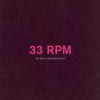 Joining Ju-Jikan: Ten Hours Of Sound From Japan and Variable Resistance: Ten Hours of Sound From Australia, 33 RPM is the companion disc to the newest installment in an ongoing sound art exhibition series at SFMOMA. "Ten Hours" is part of the exhibition title and does not refer to the amount of music on this disc, which is a full length, non-mp3 sampler of different artists from the show. Like its predecessors, 33 RPM (thankfully) does not attempt a survey of its particular country's experimental music history, instead focusing largely on newer artists with a few older luminaries included for comparison and continuity.
Joining Ju-Jikan: Ten Hours Of Sound From Japan and Variable Resistance: Ten Hours of Sound From Australia, 33 RPM is the companion disc to the newest installment in an ongoing sound art exhibition series at SFMOMA. "Ten Hours" is part of the exhibition title and does not refer to the amount of music on this disc, which is a full length, non-mp3 sampler of different artists from the show. Like its predecessors, 33 RPM (thankfully) does not attempt a survey of its particular country's experimental music history, instead focusing largely on newer artists with a few older luminaries included for comparison and continuity.
 Un Caddie's last 3" CD release quickly became my favorite amongDekorder's promising early flourish of activity. The Barcelona-basedartist must be pleased with the young label (started by former DiscoBruit personnel) as Like a packed cupboardis the first full-length from outside his own Ooze.Bap imprint. Therecord is a perfect continuation of the previous Dekorder disc, abeautiful, unassuming blanket of multiethnic instrumentation arrangedvia the artist's laptop, which acts merely as a locus for connectingthe various parts of this one-man, transcontinental ensemble. Un Caddiekeeps a dreamy, spacious mood throughout, never allowing hisadventurous sound palette to the get the better of him, or driftinginto technical excess. The digital looping and splicing is just enoughto shift the focus away from the unique assimilation of mbira, kalimba,double bass, guitar, even berimbau, serving only to accentuate thestreamlined precision at the core of Cupboard's mesmerizing,coastal ambience. The meandering pace of each track nicely suits theround organics of the instruments, minimally altered and blended with adegree of restraint that allows for the special qualities of each toshine through. Un Caddie escapes easy estimations, harping on hisexploratory sound-grabbing or fusionist approach, by creating songsthat arrive with a haphazard slowness, quietly building around simple,effective figures. The comparisons to Sack & Blumm elicited by theartist's previous disc are equally apt here; he creates music with asimilarly bizarre sense of naïveté, as if performed by a child who'dgrown up in a room where of Sub-Saharan "toys" joined the Fischer-Pricepiano. The artist takes up a related agenda with Cupboard'sliner notes which include quotations from theorist John Hutnyk's"Critique of Exotica" and from Un Caddie himself, condemning thecapitalist labeling involved in any process of cultural hybridism.Going further, he has named the tracks with URLs for web resources inethnomusicology, cultural theory, and other awareness groups, makinghis interests impossible to ignore, and it's not hard to sympathizeafter time spent drifting along with this beautiful, label-less music.
Un Caddie's last 3" CD release quickly became my favorite amongDekorder's promising early flourish of activity. The Barcelona-basedartist must be pleased with the young label (started by former DiscoBruit personnel) as Like a packed cupboardis the first full-length from outside his own Ooze.Bap imprint. Therecord is a perfect continuation of the previous Dekorder disc, abeautiful, unassuming blanket of multiethnic instrumentation arrangedvia the artist's laptop, which acts merely as a locus for connectingthe various parts of this one-man, transcontinental ensemble. Un Caddiekeeps a dreamy, spacious mood throughout, never allowing hisadventurous sound palette to the get the better of him, or driftinginto technical excess. The digital looping and splicing is just enoughto shift the focus away from the unique assimilation of mbira, kalimba,double bass, guitar, even berimbau, serving only to accentuate thestreamlined precision at the core of Cupboard's mesmerizing,coastal ambience. The meandering pace of each track nicely suits theround organics of the instruments, minimally altered and blended with adegree of restraint that allows for the special qualities of each toshine through. Un Caddie escapes easy estimations, harping on hisexploratory sound-grabbing or fusionist approach, by creating songsthat arrive with a haphazard slowness, quietly building around simple,effective figures. The comparisons to Sack & Blumm elicited by theartist's previous disc are equally apt here; he creates music with asimilarly bizarre sense of naïveté, as if performed by a child who'dgrown up in a room where of Sub-Saharan "toys" joined the Fischer-Pricepiano. The artist takes up a related agenda with Cupboard'sliner notes which include quotations from theorist John Hutnyk's"Critique of Exotica" and from Un Caddie himself, condemning thecapitalist labeling involved in any process of cultural hybridism.Going further, he has named the tracks with URLs for web resources inethnomusicology, cultural theory, and other awareness groups, makinghis interests impossible to ignore, and it's not hard to sympathizeafter time spent drifting along with this beautiful, label-less music.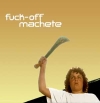 If Fuck-off Machete succeeds in nothing else, the band will at leasthave three things going for them: one of the best names for a rock bandever; one of the funniest album art concepts in recent memory; and morepress earned for the horribly underrated Ganger, whose bassist NatashaNoramly is one of the Machete's key members. It would go like this inthe record shops — Dude 1: "Who's 'Fuck-off Machete?'" Dude 2: "Thechick from Ganger's new band." D1: "Who's Ganger?" D2: "Dude, come overhere. You're not looking anymore, 'cause I know what you're getting."Now, for those who have already heard Ganger, this first step isunnecessary, and it's time to move right on to the Machete's soliddebut. This is a stronger, angrier, and dirtier band with vocals and alot more moxy. The same undertow of bass exists, and the same darkmelodies and playful attitude, but with Noramly as the ringmaster, thiscircus gets wild real quick. They have a feral quality, but there'salways a feeling like the bark is worse than the bite. That, or it'sbeing carefully held in to be unleashed with a swing that cuts off thelimbs and leaves bloody stumps. "Minority Gang" features her treatedrasp borrowing "Would I Lie to You" by the Eurythymics, but with anironic twist. She would, and she makes it plain. Most tracks start offwith an empassioned but subdued delivery, but then the aforementionedbludgeoning arrives. It never gets too bloody, though, andoccasionally, like on "Watch Them Crash," things start slow and staythere, though the Machete still gets quite a bit louder in places.Ultimately the name of the game on their debut seems to be that nakedemotion gets you everywhere. Noramly even splits vocal duties here andthere, all in the name of using the best voice for the task. Differentsongs, after all, have a different feel, and the distorted sex of hervoice may not necessarily do. By the record's end, the band lets it allout on "My Machines" and then tries out a little synth and strangenesson "Panda." It's a nice touch, showing off a little of where else theycan go. Next time, maybe. For now, it's a strong debut and it's nice tohear that Aereogramme isn't the only post-Ganger band with some chops.
If Fuck-off Machete succeeds in nothing else, the band will at leasthave three things going for them: one of the best names for a rock bandever; one of the funniest album art concepts in recent memory; and morepress earned for the horribly underrated Ganger, whose bassist NatashaNoramly is one of the Machete's key members. It would go like this inthe record shops — Dude 1: "Who's 'Fuck-off Machete?'" Dude 2: "Thechick from Ganger's new band." D1: "Who's Ganger?" D2: "Dude, come overhere. You're not looking anymore, 'cause I know what you're getting."Now, for those who have already heard Ganger, this first step isunnecessary, and it's time to move right on to the Machete's soliddebut. This is a stronger, angrier, and dirtier band with vocals and alot more moxy. The same undertow of bass exists, and the same darkmelodies and playful attitude, but with Noramly as the ringmaster, thiscircus gets wild real quick. They have a feral quality, but there'salways a feeling like the bark is worse than the bite. That, or it'sbeing carefully held in to be unleashed with a swing that cuts off thelimbs and leaves bloody stumps. "Minority Gang" features her treatedrasp borrowing "Would I Lie to You" by the Eurythymics, but with anironic twist. She would, and she makes it plain. Most tracks start offwith an empassioned but subdued delivery, but then the aforementionedbludgeoning arrives. It never gets too bloody, though, andoccasionally, like on "Watch Them Crash," things start slow and staythere, though the Machete still gets quite a bit louder in places.Ultimately the name of the game on their debut seems to be that nakedemotion gets you everywhere. Noramly even splits vocal duties here andthere, all in the name of using the best voice for the task. Differentsongs, after all, have a different feel, and the distorted sex of hervoice may not necessarily do. By the record's end, the band lets it allout on "My Machines" and then tries out a little synth and strangenesson "Panda." It's a nice touch, showing off a little of where else theycan go. Next time, maybe. For now, it's a strong debut and it's nice tohear that Aereogramme isn't the only post-Ganger band with some chops. This debut from Donato Wharton is the lost soundtrack to the works ofAsimov, where each track tells of a different character in a newsituation, like the various stages and chapters of "I, Robot." Storieslike these must be trapped in Wharton's head, but my imagination ranwild to create chapters of my own. I found the record to be more of alove tale, where computers and devices feel, for the first time, realemotions, and try to move through life with this new knowledge, only tofind how crippling these newfound and deeply wondered about feelingsare. The facts — that Wharton comes from Cardiff through Stuttgart andspends his time composing music for theater works — all have voices inhis brand of electronic music. All these experiences are present andaccounted for when the sounds plays through the speakers. It's theemotions and feelings that are created that make this truly unique, andon TrabantenWharton uses classic sounds to compose songs that raise genuine imagesand memories. "Built to Fail" starts this vision off right: the trackis all awkward rhythms formed by the splicing of tracks to create astumbling effect. There's hope, like the whole thing will get on itsfeet and walk like it manages to at the end, but ultimately it willfall apart again. It has to, because any effort of this kind willultimately due to the weight and pressure of it all. "Silvester" beepsand clicks like a pining love, like a machine falls in love with thevoice that travels on its wires. "Is That While Yr Still on Earth" iseavesdropping on multiple lines: the first hint that these dreams canturn dark, destroying what creates or feels them equally. And so thestory progresses, track after track, as the wires try to own andpossess more that they can call their own, only to find out in the endthat they can't really own anything. Depressing, sure, but it's still amarvel. Just when I think this whole digital revolution is a crock andthat the whole thing should just implode upon itself, I hear a CD likethis one. The real crock is this: the promise of technology producingall these frank and amazing artists purely by the mass availability ofsampling and recording technologies for anyone to use on their Mac orPC. There still must be artistry of some sort, some originality orunique voice that demands this technology to truly be heard, andWharton definitely has that in spades.
This debut from Donato Wharton is the lost soundtrack to the works ofAsimov, where each track tells of a different character in a newsituation, like the various stages and chapters of "I, Robot." Storieslike these must be trapped in Wharton's head, but my imagination ranwild to create chapters of my own. I found the record to be more of alove tale, where computers and devices feel, for the first time, realemotions, and try to move through life with this new knowledge, only tofind how crippling these newfound and deeply wondered about feelingsare. The facts — that Wharton comes from Cardiff through Stuttgart andspends his time composing music for theater works — all have voices inhis brand of electronic music. All these experiences are present andaccounted for when the sounds plays through the speakers. It's theemotions and feelings that are created that make this truly unique, andon TrabantenWharton uses classic sounds to compose songs that raise genuine imagesand memories. "Built to Fail" starts this vision off right: the trackis all awkward rhythms formed by the splicing of tracks to create astumbling effect. There's hope, like the whole thing will get on itsfeet and walk like it manages to at the end, but ultimately it willfall apart again. It has to, because any effort of this kind willultimately due to the weight and pressure of it all. "Silvester" beepsand clicks like a pining love, like a machine falls in love with thevoice that travels on its wires. "Is That While Yr Still on Earth" iseavesdropping on multiple lines: the first hint that these dreams canturn dark, destroying what creates or feels them equally. And so thestory progresses, track after track, as the wires try to own andpossess more that they can call their own, only to find out in the endthat they can't really own anything. Depressing, sure, but it's still amarvel. Just when I think this whole digital revolution is a crock andthat the whole thing should just implode upon itself, I hear a CD likethis one. The real crock is this: the promise of technology producingall these frank and amazing artists purely by the mass availability ofsampling and recording technologies for anyone to use on their Mac orPC. There still must be artistry of some sort, some originality orunique voice that demands this technology to truly be heard, andWharton definitely has that in spades. After unveiling their unique brand of instrumental heaviness on lastyear's untitled EP, Pelican nudge things one step further with this,their first full-length release. Australasia is that fictional landmass which, along with the Americas and Great Britain, comprises theempire of Oceania in George Orwell's 1984. Pelican create a similar topography of impending dystopia with the dark, crushing riffs of their Australasia. Pelican unashamedly summon the spirits of Black Sabbath, Master of Puppets-eraMetallica and The Melvins, creating a six track album of surprisingdynamism and complexity. Every track uses the same simple sonicpalette: heroic minor-key riffing interwoven with layers of crunchy,expansive rhythm guitar. Their long-form compositions take each themethrough several dramatic tempo changes, allowing them the chance torevisit certain key themes and gain momentum with each repetition.Pelican are instrumentalists of the highest order; their guitarsymphonies are so incredibly lyrical that vocals would be animposition. Comparisons to post-rockers Explosions in the Sky might beappropriate, but Pelican aren't interested in delayed gratification.They cut out all of the chamber-ensemble warm-up and dive in headfirst,barreling forward on their own intense propulsion. "Nightendday"imagines a sky filled with smokestacks and searchlights, a brutaldictatorial regime where the only escape is to rock as fully and ashard as possible, breaking through the barbed-wired borders of tyranny."Angel Tears" is absolutely stunning, a sweeping, cinematic dirgeimbued with a driving rhythm section that keeps threatening to upenditself, but miraculously manages to stay on track. Track five, which ispurposely left untitled, is the album's sole respite: an hauntinglybeautiful symphony of interlacing acoustic guitars with subtlesynthesizer flourishes. It's Pelican's answer to the heavy metal powerballad. The album ends on a high note, with the monolithic 11-minutetitle track, full of fuzzy, cyclical riffage so massive, at highvolumes on headphones it threatens to deepen the fissure of my brain.Calling this "stoner metal" would be a disservice to the precision andaccuracy with which the foursome deploy their arsenal. Australasia is a substantial album, but it nonetheless leaves me with a desire to hear more.
After unveiling their unique brand of instrumental heaviness on lastyear's untitled EP, Pelican nudge things one step further with this,their first full-length release. Australasia is that fictional landmass which, along with the Americas and Great Britain, comprises theempire of Oceania in George Orwell's 1984. Pelican create a similar topography of impending dystopia with the dark, crushing riffs of their Australasia. Pelican unashamedly summon the spirits of Black Sabbath, Master of Puppets-eraMetallica and The Melvins, creating a six track album of surprisingdynamism and complexity. Every track uses the same simple sonicpalette: heroic minor-key riffing interwoven with layers of crunchy,expansive rhythm guitar. Their long-form compositions take each themethrough several dramatic tempo changes, allowing them the chance torevisit certain key themes and gain momentum with each repetition.Pelican are instrumentalists of the highest order; their guitarsymphonies are so incredibly lyrical that vocals would be animposition. Comparisons to post-rockers Explosions in the Sky might beappropriate, but Pelican aren't interested in delayed gratification.They cut out all of the chamber-ensemble warm-up and dive in headfirst,barreling forward on their own intense propulsion. "Nightendday"imagines a sky filled with smokestacks and searchlights, a brutaldictatorial regime where the only escape is to rock as fully and ashard as possible, breaking through the barbed-wired borders of tyranny."Angel Tears" is absolutely stunning, a sweeping, cinematic dirgeimbued with a driving rhythm section that keeps threatening to upenditself, but miraculously manages to stay on track. Track five, which ispurposely left untitled, is the album's sole respite: an hauntinglybeautiful symphony of interlacing acoustic guitars with subtlesynthesizer flourishes. It's Pelican's answer to the heavy metal powerballad. The album ends on a high note, with the monolithic 11-minutetitle track, full of fuzzy, cyclical riffage so massive, at highvolumes on headphones it threatens to deepen the fissure of my brain.Calling this "stoner metal" would be a disservice to the precision andaccuracy with which the foursome deploy their arsenal. Australasia is a substantial album, but it nonetheless leaves me with a desire to hear more.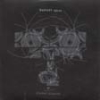 The electronic and live instrumentation mixing duo of Adrian Corker andPaul Conboy have recently been writing the next Bomb the Bass albumwith Tim Simenon. Ahead of that, Corker/Conboy's Radiant Idiotis a dark obsession with minor chords that transforms their music intoa beautiful new creature with a life all its own. Their sophomore setis a true renovation of their formerly derivative sound with intriguingadditions and finer melodies. The electronics are more an atmospherictouch than an active participant, and with new instruments joining thegroup's repertoire, the possibilities are endless. Shutters anddelicate guitar open the record, and soon hefty live drums and a lowmuddy bass join in, and the guitar and the song go all filthy energy. Afull-on freak-out ensues, reminding me vaguely of the new direction ofPele, and suddenly I'm eager for more. There's a drive, an urgencypresent, on these songs that may have been there before, but never thisovert, and it's a breath of fresh air. The music is still so structuredand controlled in its fluidity, like every move is planned, but I coulddefinitely tell that these two were taking chances this time around.The slow groove of "Portland Grove Am" is simply lovely and comforting,with a simple repeated melody and layered stringed instruments overtop.Interesting guest contributions rear their heads here and there, likeIan Dixon's pulse-quickening trumpet work on "Get 1 Over." Changingrhythms also bring a freshness: a shuffle here and a dirge there with alittle bit of a groove in between creates a great make-out record, withshifts in tempo bringing peaks and valleys in the action. Strangely,the only track that didn't do anything for me is the title track, alsothe longest at just over eight minutes. It moves like a symphony,gracefully sliding in and out of different phases, but it reallydoesn't get where it feels like it's going. Still, the generalexperience of the album is a pleasing one, and a real evolution fromtheir previous efforts.
The electronic and live instrumentation mixing duo of Adrian Corker andPaul Conboy have recently been writing the next Bomb the Bass albumwith Tim Simenon. Ahead of that, Corker/Conboy's Radiant Idiotis a dark obsession with minor chords that transforms their music intoa beautiful new creature with a life all its own. Their sophomore setis a true renovation of their formerly derivative sound with intriguingadditions and finer melodies. The electronics are more an atmospherictouch than an active participant, and with new instruments joining thegroup's repertoire, the possibilities are endless. Shutters anddelicate guitar open the record, and soon hefty live drums and a lowmuddy bass join in, and the guitar and the song go all filthy energy. Afull-on freak-out ensues, reminding me vaguely of the new direction ofPele, and suddenly I'm eager for more. There's a drive, an urgencypresent, on these songs that may have been there before, but never thisovert, and it's a breath of fresh air. The music is still so structuredand controlled in its fluidity, like every move is planned, but I coulddefinitely tell that these two were taking chances this time around.The slow groove of "Portland Grove Am" is simply lovely and comforting,with a simple repeated melody and layered stringed instruments overtop.Interesting guest contributions rear their heads here and there, likeIan Dixon's pulse-quickening trumpet work on "Get 1 Over." Changingrhythms also bring a freshness: a shuffle here and a dirge there with alittle bit of a groove in between creates a great make-out record, withshifts in tempo bringing peaks and valleys in the action. Strangely,the only track that didn't do anything for me is the title track, alsothe longest at just over eight minutes. It moves like a symphony,gracefully sliding in and out of different phases, but it reallydoesn't get where it feels like it's going. Still, the generalexperience of the album is a pleasing one, and a real evolution fromtheir previous efforts. The most recent in an avalanche of new music taking a crack at resurrecting the dreamy, shoegazer pop of bands like My Bloody Valentine, Slowdive and Ride, Pluramon's Dreams Top Rock only distinguishes itself from the rest of the pack by not being quite as predictable. It helps that Marcus Schmickler has recruited Julee Cruise—the serene, childlike chanteuse of so many David Lynch soundtracks—to contribute vocals to the album. Julee's last album, the dreadful The Art of Being a Girl, was such a wasted opportunity that it's a pleasure to hear her placed in the hands of a producer who can wield her peculiar vocal talents properly.
The most recent in an avalanche of new music taking a crack at resurrecting the dreamy, shoegazer pop of bands like My Bloody Valentine, Slowdive and Ride, Pluramon's Dreams Top Rock only distinguishes itself from the rest of the pack by not being quite as predictable. It helps that Marcus Schmickler has recruited Julee Cruise—the serene, childlike chanteuse of so many David Lynch soundtracks—to contribute vocals to the album. Julee's last album, the dreadful The Art of Being a Girl, was such a wasted opportunity that it's a pleasure to hear her placed in the hands of a producer who can wield her peculiar vocal talents properly.
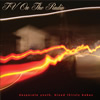 Young Liars, released this past summer, was an intoxicating shotof dark, precise sound; at once both deeply passionate and eerilychilly, the product of a gospel choral that had lost its way andpreferred to creep out unsuspecting subway riders rather than bask inany holy warmth. While that EP showcased a few densely packed tracks,their new LP finds that intensity strung across a larger canvas,changing the shape and color into something that asks for more patienceand observation. "The Wrong Way" is a charmer, thudding along withsoupy bass and percussion as baritone and alto saxophones bleat andsupport the vocal harmonies of the three members, which sound like asnapping ragtime chorus, full bodied and drawling. Though the musicalfoundation is simple and loopy, it serves as a perfect background forthe expressive vocals that rise and fall with bursts of energy, beggingfor the pews to raise their hands and chime in. "Ambulance" eschews anykind of pretense that Tunde Adebimpe's vocals are not the core of thisband's power, dropping the fuzzy noise collages for an acapellaexcursion. Adebimpe's breathy triplets on the song's chorus of "I /will be / your / ac / ci / dent / if you / will be / my am / bu /lance," caress every syllable, giving them each proper considerationbefore spilling them out in his smooth baritone. Unfortunately, theslower tracks, like "Don't Love You," lack the amorphous, ephemeralquality that made "Blind" from their past EP such a spooky, alluringlisten. Where before a lurch was arresting, visceral, here they areclumsy and cautious. "Poppy" suffers from a relatively banal guitarriff that comprises the bulk of the track. While this is hardly enoughto invalidate any interest in Desperate Youth, Bloodthirsty Babes,it is indicative that the group finds themselves searching for the nextstep, the next mode for their sound. "Bomb Yourself" finds thosebrilliant harmonies sprawling across a bass heavy, dub-inflected bed,capturing a deep groove. The raw quality of TV on the Radio's energy,and their recklessly experimental tendencies make listening to everynook and cranny of their tinkered sound interesting, and hints at evenmore dramatic pieces in the future.
Young Liars, released this past summer, was an intoxicating shotof dark, precise sound; at once both deeply passionate and eerilychilly, the product of a gospel choral that had lost its way andpreferred to creep out unsuspecting subway riders rather than bask inany holy warmth. While that EP showcased a few densely packed tracks,their new LP finds that intensity strung across a larger canvas,changing the shape and color into something that asks for more patienceand observation. "The Wrong Way" is a charmer, thudding along withsoupy bass and percussion as baritone and alto saxophones bleat andsupport the vocal harmonies of the three members, which sound like asnapping ragtime chorus, full bodied and drawling. Though the musicalfoundation is simple and loopy, it serves as a perfect background forthe expressive vocals that rise and fall with bursts of energy, beggingfor the pews to raise their hands and chime in. "Ambulance" eschews anykind of pretense that Tunde Adebimpe's vocals are not the core of thisband's power, dropping the fuzzy noise collages for an acapellaexcursion. Adebimpe's breathy triplets on the song's chorus of "I /will be / your / ac / ci / dent / if you / will be / my am / bu /lance," caress every syllable, giving them each proper considerationbefore spilling them out in his smooth baritone. Unfortunately, theslower tracks, like "Don't Love You," lack the amorphous, ephemeralquality that made "Blind" from their past EP such a spooky, alluringlisten. Where before a lurch was arresting, visceral, here they areclumsy and cautious. "Poppy" suffers from a relatively banal guitarriff that comprises the bulk of the track. While this is hardly enoughto invalidate any interest in Desperate Youth, Bloodthirsty Babes,it is indicative that the group finds themselves searching for the nextstep, the next mode for their sound. "Bomb Yourself" finds thosebrilliant harmonies sprawling across a bass heavy, dub-inflected bed,capturing a deep groove. The raw quality of TV on the Radio's energy,and their recklessly experimental tendencies make listening to everynook and cranny of their tinkered sound interesting, and hints at evenmore dramatic pieces in the future. 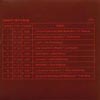 FT is for Folktales, a series of three sets of three 3"CDs that Crouton has released over recent years, each disc devoted to asingle artist of electroacoustic, experimental electronic, or impovorientation. For a finale, this full-length disc finds Tietchens'remixing all three triptychs, producing nine individual tracks, each apredictably drastic reinterpretation of its source disc. While the "+"might suggest a thickening of each track into the kind of throbbing,gray industro-ambiance that made Tietchens' name the mark of quality ontoo many lost cassette comps from decades past, his approach here ismuch more subtractive, closer to the brutally minimal, ascetictechnique begun somewhere around the more recent Menge series.The new mixes reduce nearly every track to a widely-scattered array ofsound fragments, never slipping into glitch-like impressionism, ratherworking through a pensive, reserved process of manipulation, eachcompressed or bloated bit of sound dust given ample, isolated space.Tietchens seems intent on discovering (or creating), in each piece,those moments which stare blankly back from the disc's digital sheen,which appear absent of any relation to the whole yet arrive with acryptic, almost mocking air. The artist has always kept his dark, wilysense of humor in the background of his releases (often highlighted bya E.M. Cioran aphorism or two), and this disc is no exception. The jokehere, for me at least, is that Tietchens is, more than ever, toyingwith the idea of creating music where human touch has absolutely nosignificance. The punch line comes with the realization that Tietchensis remixing others' compositions, making his job necessarily harder. Each disc in the original Folktalesseries was conceptualized around the idea of narrative, with thevarious artists essentially telling stories through sound, makingTietchens accomplishment, though idiosyncratic itself, an effectiveerasure of the others' storytelling. His reconstructions could not bemore remote; I'm even wary of using an adjective like "cold" for fearof suggesting that anything atmospheric emerges. The minisculecrunches, warped thuds, and deadened hums that become windows into theoriginal recordings do allow for glimpses into the unique flowand sonorous quality of each, however Tietchens displays a tested skillfor introducing shards of melody or motion while almost simultaneouslyenacting their disappearance. It's as if wrapped up in each stuntedswell, each vestige of previous creator and previous completion, isevidence of a fundamental insubstantiality. The artist's talents aremost remarkable when applied to the coarse saxophone and violincompositions from Bhob Rainey and Dan Warburton. Tietchens is able toretain the distinctiveness of each instrument, even allowing for a fewmelodic intervals to take shape, but he completely rejects any of thepersonality that comes with such age-old devices, turning them on anangle that emphasizes only their existence as machines, simpleconveyances of empty sound. While on paper the artist's modus operandihas all the charm of a night spent sleeping on a board, rest assuredthat Tietchens does not let the potential for enjoyment slip throughthe cracks. He understands the audacity of his place within the littlecharade he's created and takes care to make the results more appealingthan FT+'s faux-laboratory chart cover would indicate. This ismerely Tietchens as E.M. Cioran's fatalistic hero, playing theinvisible hand of time, sweeping the folklore to the hens with a smileon his face.
FT is for Folktales, a series of three sets of three 3"CDs that Crouton has released over recent years, each disc devoted to asingle artist of electroacoustic, experimental electronic, or impovorientation. For a finale, this full-length disc finds Tietchens'remixing all three triptychs, producing nine individual tracks, each apredictably drastic reinterpretation of its source disc. While the "+"might suggest a thickening of each track into the kind of throbbing,gray industro-ambiance that made Tietchens' name the mark of quality ontoo many lost cassette comps from decades past, his approach here ismuch more subtractive, closer to the brutally minimal, ascetictechnique begun somewhere around the more recent Menge series.The new mixes reduce nearly every track to a widely-scattered array ofsound fragments, never slipping into glitch-like impressionism, ratherworking through a pensive, reserved process of manipulation, eachcompressed or bloated bit of sound dust given ample, isolated space.Tietchens seems intent on discovering (or creating), in each piece,those moments which stare blankly back from the disc's digital sheen,which appear absent of any relation to the whole yet arrive with acryptic, almost mocking air. The artist has always kept his dark, wilysense of humor in the background of his releases (often highlighted bya E.M. Cioran aphorism or two), and this disc is no exception. The jokehere, for me at least, is that Tietchens is, more than ever, toyingwith the idea of creating music where human touch has absolutely nosignificance. The punch line comes with the realization that Tietchensis remixing others' compositions, making his job necessarily harder. Each disc in the original Folktalesseries was conceptualized around the idea of narrative, with thevarious artists essentially telling stories through sound, makingTietchens accomplishment, though idiosyncratic itself, an effectiveerasure of the others' storytelling. His reconstructions could not bemore remote; I'm even wary of using an adjective like "cold" for fearof suggesting that anything atmospheric emerges. The minisculecrunches, warped thuds, and deadened hums that become windows into theoriginal recordings do allow for glimpses into the unique flowand sonorous quality of each, however Tietchens displays a tested skillfor introducing shards of melody or motion while almost simultaneouslyenacting their disappearance. It's as if wrapped up in each stuntedswell, each vestige of previous creator and previous completion, isevidence of a fundamental insubstantiality. The artist's talents aremost remarkable when applied to the coarse saxophone and violincompositions from Bhob Rainey and Dan Warburton. Tietchens is able toretain the distinctiveness of each instrument, even allowing for a fewmelodic intervals to take shape, but he completely rejects any of thepersonality that comes with such age-old devices, turning them on anangle that emphasizes only their existence as machines, simpleconveyances of empty sound. While on paper the artist's modus operandihas all the charm of a night spent sleeping on a board, rest assuredthat Tietchens does not let the potential for enjoyment slip throughthe cracks. He understands the audacity of his place within the littlecharade he's created and takes care to make the results more appealingthan FT+'s faux-laboratory chart cover would indicate. This ismerely Tietchens as E.M. Cioran's fatalistic hero, playing theinvisible hand of time, sweeping the folklore to the hens with a smileon his face. 

